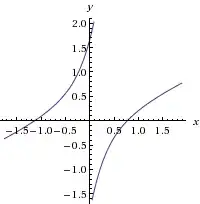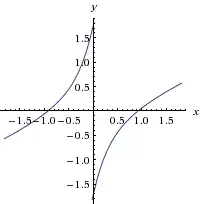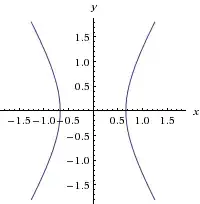Original Conic

First eliminate the offset terms (factors of $x$ and $y$ alone) by finding the "center".
$$\left. \begin{align} \frac{{\rm d}}{{\rm d} x} (39x^2+11y^2-96xy+14x+2y-34)&=0
\\ \frac{{\rm d}}{{\rm d} y} (39x^2+11y^2-96xy+14x+2y-34)&=0 \end{align} \right\} \; \begin{aligned} x & = \frac{1}{15} \\ y & = \frac{1}{5} \end{aligned} $$
Now we substitute $$ \begin{align} x & \rightarrow x + \frac{1}{15} \\ y & \rightarrow y + \frac{1}{5} \end{align} $$
The conic is now
$$ 39 x^2 - 96 x y + 11 y^2 - \frac{100}{3} = 0 $$

Now lets find the rotation angle $\theta$ that gets rid of the $xy$ terms
One way to do this is to apply a rotation $$R = \begin{vmatrix} \cos\theta & -\sin \theta & 0 \\ \sin\theta & \cos\theta & 0 \\ 0 & 0 & 1 \end{vmatrix}$$ to the homogeneous coordinates $(x,y,1)$ transforming the conic equation from
$$ 39 x^2 - 96 x y + 11 y^2 - \frac{100}{3} = 0 \rightarrow \\ \begin{pmatrix} x \\ y \\ 1 \end{pmatrix} ^ \top \begin{vmatrix} 39 & -\frac{96}{2} & 0 \\ - \frac{96}{2} & 11 & 0 \\ 0 & 0 & -\frac{100}{3} \end{vmatrix} \begin{pmatrix} x \\ y \\ 1 \end{pmatrix} = 0 $$
to
$$\begin{pmatrix} x \\ y \\ 1 \end{pmatrix} ^ \top \begin{vmatrix} \cos\theta & -\sin \theta & 0 \\ \sin\theta & \cos\theta & 0 \\ 0 & 0 & 1 \end{vmatrix}^\top \begin{vmatrix} 39 & -\frac{96}{2} & 0 \\ - \frac{96}{2} & 11 & 0 \\ 0 & 0 & -\frac{100}{3} \end{vmatrix} \begin{vmatrix} \cos\theta & -\sin \theta & 0 \\ \sin\theta & \cos\theta & 0 \\ 0 & 0 & 1 \end{vmatrix} \begin{pmatrix} x \\ y \\ 1 \end{pmatrix} = 0 $$
$$ \begin{pmatrix} x \\ y \\ 1 \end{pmatrix} ^ \top \begin{vmatrix} 28 \cos^2 \theta-96 \sin\theta\cos\theta+11 & -96 \cos^2\theta-28 \sin\theta\cos\theta+48 & 0 \\ \boxed{-96 \cos^2\theta-28 \sin\theta\cos\theta+48} & 28\sin^2\theta + 96 \sin\theta\cos\theta+11 & 0 \\ 0 & 0 & -\frac{100}{3} \end{vmatrix} \begin{pmatrix} x \\ y \\ 1 \end{pmatrix} = 0 $$
$$ -96 \cos^2\theta-28 \sin\theta\cos\theta+48 = 0 \\ 96 \left( \frac{1}{2} + \frac{\cos 2\theta}{2} \right) + 28 \frac{\sin 2\theta}{2} = 48 \\ 48 \cos(2\theta) + 14 \sin(2 \theta) = 0 \\ \tan(2\theta) + \frac{24}{7} =0 \\ \theta = -\frac{1}{2} \arctan\left( \frac{24}{7} \right) $$
This angle transforms the conic with rotated cordinates into
$$ Ax^2 + B y^2 + C =0 \\ (75) x^2 + (- 26) y^2 + (- \frac{100}{3}) = 0 $$

Lastly for an ellipse with major radius $r_x$ and minor radius $r_y$ the eccentricity is defined as $$\epsilon = \sqrt{1-\frac{r_y^2}{r_x^2}}$$
Now we convert the conic $Ax^2+By^2+C=0$ into $\left( \frac{x}{r_x}\right)^2 + \left(\frac{y}{r_y}\right)^2 = 1$ form in order to get the major and minor dimensions $r_x$ and $r_y$.
This is done with $$ \left. \frac{x^2}{-C/A} + \frac{y^2}{-C/B} = 1 \right\} \begin{aligned} r_x^2 & =-C/A=\frac{4}{9} \\ r_y^2 & = -C/B =-\frac{50}{39} \end{aligned}$$
The eccentricity is thus
$$ \epsilon = \sqrt{1 - \frac{r_y^2}{r_x^2}} = \sqrt{1-\frac{A}{B}}= \sqrt{1+\frac{75}{26}} = 1.9709427654336\ldots $$
NOTE: That only the coefficients $A$ and $B$ are used in the eccentricity calculation. Different values of $C$ would scale the radii differently but their ratio depends on $A$ and $B$ only.
There is a co-eccentricity defined here as $\epsilon^\star = \sqrt{1-\frac{B}{A}} = 1.160459679035 \ldots$


